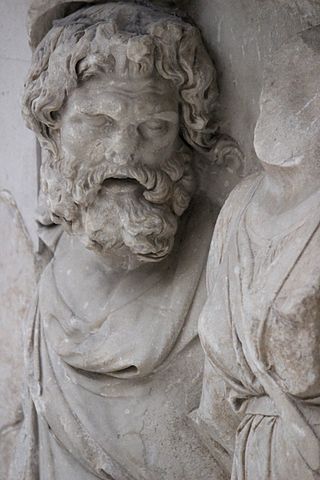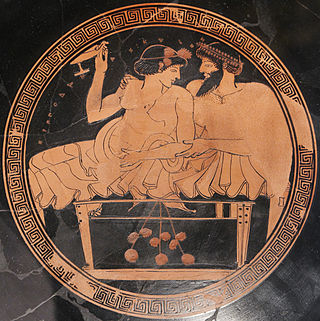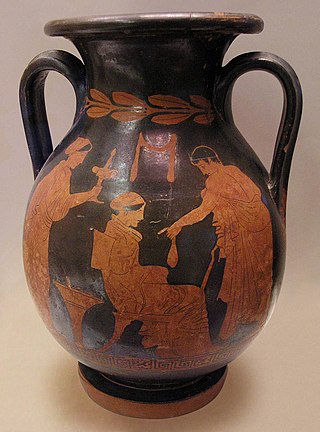Related Research Articles

In Greek mythology, Nereus was the eldest son of Pontus and Gaia, with Pontus himself being a son of Gaia. Nereus and Doris became the parents of 50 daughters and a son (Nerites), with whom Nereus lived in the Aegean Sea.

Zeus is the sky and thunder god in ancient Greek religion and mythology, who rules as king of the gods on Mount Olympus. His name is cognate with the first syllable of his Roman equivalent Jupiter.

Helen, also known as Helen of Troy, Helen of Argos, or Helen of Sparta, and in Latin as Helena, was a figure in Greek mythology said to have been the most beautiful woman in the world. She was believed to have been the daughter of Zeus and Leda or Nemesis, and the sister of Clytemnestra, Castor, Pollux, Philonoe, Phoebe and Timandra. She was married to King Menelaus of Sparta "who became by her the father of Hermione, and, according to others, of Nicostratus also." Her abduction by Paris of Troy was the most immediate cause of the Trojan War.
In Greek mythology, Deimos is the personification of fear. He is the son of Ares and Aphrodite, and the brother of Phobos. Deimos served to represent the feelings of dread and terror that befell those before a battle, while Phobos personified feelings of fear and panic in the midst of battle.

In Greek mythology, Hellen is the eponymous progenitor of the Hellenes. He is the child of Deucalion and Pyrrha, and the father of three sons, Dorus, Xuthus, and Aeolus, by whom he is the ancestor of the Greek peoples.

In Greek mythology, Peitho is the personification of persuasion. She is typically presented as an important companion of Aphrodite. Her opposite is Bia, the personification of force. As a personification, she was sometimes imagined as a goddess and sometimes an abstract power with her name used both as a common and proper noun. There is evidence that Peitho was referred to as a goddess before she was referred to as an abstract concept, which is rare for a personification. Peitho represents both sexual and political persuasion. She is associated with the art of rhetoric.

Aspasia was a metic woman in Classical Athens. Born in Miletus, she moved to Athens and began a relationship with the statesman Pericles, with whom she had a son named Pericles the Younger. According to the traditional historical narrative, she worked as a courtesan and was tried for asebeia (impiety), though modern scholars have questioned the factual basis for either of these claims, which both derive from ancient comedy. Though Aspasia is one of the best-attested women from the Greco-Roman world, and the most important woman in the history of fifth-century Athens, almost nothing is certain about her life.

A hetaira, Latinized as hetaera, was a type of courtesan or prostitute in ancient Greece, who served as an artist, entertainer, and conversationalist in addition to providing sexual service. Custom excluded the wives and daughters of Athenian citizens from the symposium, but this prohibition did not extend to hetairai, who were often foreign born and could be highly educated. Other female entertainers made appearances in the otherwise male domain, but hetairai joined the male guests in their sexual joking, sometimes evidencing a wide knowledge of literature in their contributions.
Lycurgus was the legendary lawgiver of Sparta, credited with the formation of its eunomia, involving political, economic, and social reforms to produce a military-oriented Spartan society in accordance with the Delphic oracle. The Spartans in the historical period honoured him as god.

Phryne was an ancient Greek hetaira (courtesan). Born Mnesarete, she was from Thespiae in Boeotia, but seems to have lived most of her life in Athens, where she became one of the wealthiest women in Greece.
The Menexenus is a Socratic dialogue of Plato, traditionally included in the seventh tetralogy along with the Greater and Lesser Hippias and the Ion. The speakers are Socrates and Menexenus, who is not to be confused with Socrates' son Menexenus. The Menexenus of Plato's dialogue appears also in the Lysis, where he is identified as the "son of Demophon", as well as the Phaedo.

Prostitution was a common aspect of ancient Greece. In the more important cities, and particularly the many ports, it employed a significant number of people and represented a notable part of economic activity. It was far from being clandestine; cities did not condemn brothels, but rather only instituted regulations on them.

Philaenis of Samos was supposedly the author of a famous ancient sex manual. According to a surviving fragment of a treatise which claims to have been written by her, she was from Samos, and her father was called Ocymenes. However, many modern scholars consider "Philaenis" a fictional character whose persona may have been adopted by a variety of erotic writers. Two satirical Greek epigrams from the Palatine Anthology by the poets Aeschrion of Samos and Dioscorides purport to defend Philaenis's reputation by insisting that she did not write the treatise attributed to her. Aeschrion instead insists that the treatise was written by the Athenian sophist Polycrates. The reputed writings of Philaenis were well known throughout classical antiquity and scholars believe that they may have influenced Ovid's Ars Amatoria.
Neaira, also Neaera, was a hetaera who lived in the 4th century BC in ancient Greece. She was brought to trial between 343 and 340 BC, accused of marrying an Athenian citizen illegally and misrepresenting her daughter as an Athenian citizen.

In Greek mythology, Phoenix or Phoinix was the eponym of Phoenicia who together with his brothers were tasked to find their abducted sister Europa.
Bilistiche or Belistiche was a Hellenistic courtesan of Ptolemy II Philadelphus and winner of the 264 BC Olympic Games in tethrippon and synoris.

The study of the lives of women in classical Athens has been a significant part of classical scholarship since the 1970s. The knowledge of Athenian women's lives comes from a variety of ancient sources. Much of it is literary evidence, primarily from tragedy, comedy, and oratory; supplemented with archaeological sources such as epigraphy and pottery. All of these sources were created by—and mostly for—men: there is no surviving ancient testimony by classical Athenian women on their own lives.
"Against Neaera" was a prosecution speech delivered by Apollodoros of Acharnae against the freedwoman Neaera. It was preserved as part of the Demosthenic corpus, though it is widely considered to be pseudo-Demosthenic, possibly written by Apollodoros himself. The speech was part of the prosecution of Neaera, a hetaera who was accused of unlawfully marrying an Athenian citizen. Though the speech claims that the case was brought for personal reasons, the date of the prosecution has led scholars to believe that it was in fact politically motivated. In common with most legal cases from ancient Athens, the outcome is unknown.

Gnathaena was an Athenian hetaira, a class of ancient Greek prostitutes who were companions to wealthy men. Though there is no source for either her date of birth or date of death, Gnathaena is known to have lived during the 4th century BCE due to her affiliations with various men of the era. Her most notable lover was Diphilus, an Athenian New Comedy playwright. According to Athenaeus, Gnathaena was famous for her lavish parties and witty repartee, and even wrote a treatise on proper conduct at her symposiums entitled, "Rules for Dining in Company".
Aspasia of Phocaea, daughter of Hermotimus, was carried away from her country to be in the harem of the Achaemenid prince Cyrus the Younger, who so admired her beauty and her superior qualities of mind and character that he made her his favorite wife, nicknaming her "the wise one" (sophe). She may or may not have been a hetaira.
References
- ↑ Plut. 753 D and Them. 1; Athen. 13.576.
- ↑ Anth. Gr. 7.306.
- ↑ Plut. Amat. 9. "But you will say, since it may be a man's misfortune to be so hampered, would it not be better to marry some Thracian Abrotonon or some Milesian Bacchis, whom he can get in the market for money and a handful of nuts?"
- ↑ Kapparis 2017, p. 408.
- ↑ Lucian, DMeretr. 1. "Glycera to Thais: Thais, do you remember that soldier, the Acarnanian, who had in the past kept Abrotonum and after that he became my lover, the one who was dressing up, that one with the chlamys , or have you forgotten him?"
- ↑ Kapparis 2017, pp. 101–4, 408.
- ↑ Plut. Rom. 4.4; Zonaras Epit. Hist. 2.88; Eust. Com. Od. 2.275,323.
- ↑ Dion. Hal. Ant. Rom. 1.84.4.
- ↑ Kapparis 2017, p. 386.
- 1 2 Kapparis 2017, p. 387.
- ↑ Kapparis 2017, p. 388.
- ↑ Kapparis 2017, p. 390.
- ↑ Diogenes Laërtius, Lives of the Philosophers 3.31; Athenaeus, Deipnosophists 13.589c.
- ↑ Anthologia Graeca 7.217. "I hold Archeanassa the courtesan from Colophon even on whose wrinkles sweet Love sat. Ah, ye lovers, who plucked the fresh flowers of her youth in its first piercing brilliance, through what a fiery furnace did you pass!"
- ↑ Hdt. 2.135. "The courtesans of Naucratis seem to be peculiarly alluring, for the woman of whom this story is told became so famous that every Greek knew the name of Rhodopis, and later on a certain Archidice was the theme of song throughout Greece, although less celebrated than the other."
- 1 2 Kapparis 2017, p. 391.
- ↑ Hyp. fr. 13–26 Jensen; Hermippus fr. 68a1 Wehrli = Athen. 13.58; Athen. 13.586–590; Plut. Mor. 849.
- ↑ Kapparis 2017, pp. 112, 121–2, 177, 255–8, 262, 391.
- ↑ Hegesander (Fragm. Hist. Graec. IV. fr. 8) = Athen. 4.64 (167d, e).
- ↑ Kennedy 2014, p. 75.
- ↑ Bicknell 1982, p. 245.
- ↑ Henry 1995, pp. 138–9, n. 9.
- ↑ Glenn 1994, p. 184.
- ↑ Kennedy 2014, p. 77.
- ↑ Kennedy 2014, pp. 75, 87, n. 1.
- ↑ Kapparis 2017, p. 104.
- ↑ Kapparis 2017, p. 393.
- ↑ FGrH 115 F 253; Athen. 13.67.
- 1 2 Athen. 13.66.
- ↑ Athen. 11.99.
- ↑ Athen. 4.48, 78.
- ↑ Athen. 4.50, 14.51.
- ↑ Athen. 14.74.
- ↑ Hayward 1926, p. 46.
- ↑ Kapparis 2017, pp. 394–5.
- 1 2 Kapparis 2017, p. 394.
- ↑ Hayward 1926, p. xi.
- ↑ Paus. 5.8.11. "Afterwards they added races for chariots and pairs of foals, and for single foals with rider. It is said that the victors proclaimed were: for the chariot and pair, Belistiche, a woman from the seaboard of Macedonia; for the ridden race, Tlepolemus of Lycia. Tlepolemus, they say, won at the hundred and thirty-first Festival, and Belistiche at the third before this."
- ↑ Athen. 13.37 (13.596e).
- ↑ Plut. Mor. 753e.
- ↑ Ptolemy Euergetes FGrH 234 F 4 = Athen. 13.37.
- ↑ Kapparis 2017, pp. 69, 332, 396.
- ↑ Pomeroy 1990, pp. 53–5.
- ↑ Hom. Hymn Dem. 109 ff.
- ↑ Kapparis 2017, p. 400.
- ↑ Athen. 13.40.
- ↑ Plut. Dem. 27.1.
- ↑ Kapparis 2017, pp. 117–9, 400.
- ↑ Anth. Gr. 5.115, 160, 172, 173, 197, 244; 6.174; 7.711; 12.173.
- ↑ Kapparis 2017, pp. 91, 400.
- ↑ Lactant. i. 20.
- ↑ Varro, de. L. L. v. 74.
- ↑ Tac. Ann. ii. 49.
- ↑ "Flora". Dictionary of Greek and Roman Biography and Mythology . Vol. 2. 1870. pp. 175–6.
- ↑ Plin. HN.
- ↑ Plin. HN. 21.3.
- ↑ Smith 1869, p. 162.
- ↑ Theopomp. FGrH 115 F 254a = Athen. 13.50, 68.
- ↑ Ath. 13.66 (13.586, 595, 605, &c.); Alciphr. 4.2, 14, 18, 19.
- ↑ Kapparis 2017, p. 405.
- ↑ Kapparis 2017, pp. 113–6, 143–6; 151, 179, 332, 405–6.
- ↑ Athen. 13.558, 567, 577, 578.
- ↑ Kapparis 2017, pp. 406–7.
- ↑ Kapparis 2017, pp. 416–17.
- ↑ Athen. 13.34.
- 1 2 Kapparis 2017, p. 418.
- ↑ Gell. 1.8.3–6; Macrob. Sat. 2.2.11.
- ↑ Diog. Laërt. 4.7.
- ↑ Idomeneus FGrH 338 F 4a and 4b = Athen. 12.45 and 13.37.
- 1 2 3 Plut. Demetr. 16.
- ↑ Plut. Demetr. 24, 27.
- ↑ Athen. 3.101; 4.128; 6.253, 13.576, 577; 14.614.
- ↑ Plut. Demetr. 16, 19, 24, 25, 27.
- ↑ Strothmann, Meret. "Leontium [2]", Brill's New Pauly.
- ↑ Athen. 13.567, 590, 593; Plut. Mor. 849.
- ↑ Theophilus fr. 11; Menander, Colax fr. 256 = Athen. 13. 52.
- 1 2 3 4 Kapparis 2017, p. 429.
- ↑ Idomeneus FGrH 338 F 4a; Athen. 13.37.
- ↑ Athen. 13. 51.
- ↑ Athen. 13. 587.
- ↑ Athen. 13. 587, 590, 593; Plut. Mor. 849.
- ↑ Vessey 1976, pp. 80–81.
- ↑ Tsantsanoglou 1973, p. 192.
- ↑ Plant 2004, p. 45.
- ↑ FHG 4.452.
- ↑ Hayward 1926, p. 377.
- ↑ Anaxilas (fr. 22 = Athen. 13.6)
- ↑ Timocles (fr. 27 = Athen. 13.22).
- ↑ Pomeroy 1990, p. 54.
- ↑ Paus. 1.37.5. "His love for her was so great that when she died he made her a tomb which is the most noteworthy of all the old Greek tombs."
- ↑ Kapparis 2017, p. 444.
- ↑ Diod. Sic. 17.72; Plut., Alex., 38; Ath. 13.576,585; Curt. 5.7.
- ↑ . Encyclopædia Britannica . Vol. 26 (11th ed.). 1911. p. 719.
- 1 2 Plutarch, Pericles, XXIV
- ↑ Joshua 2